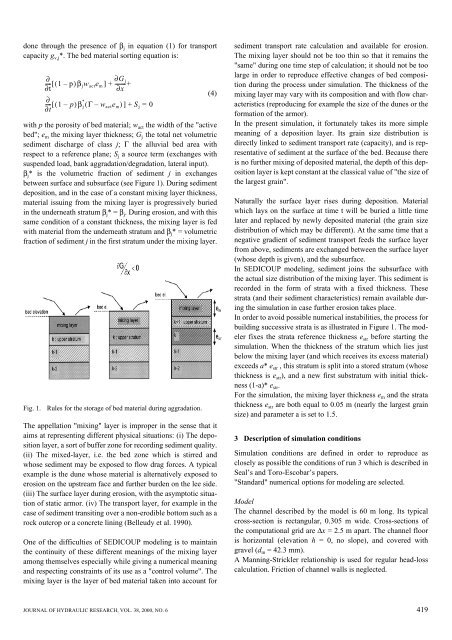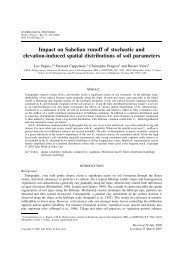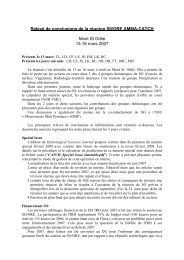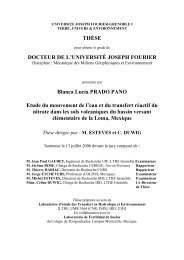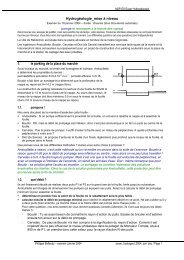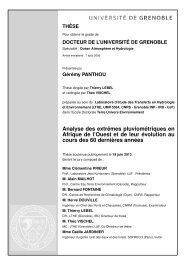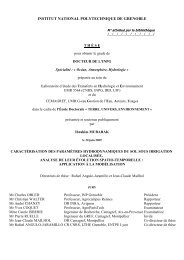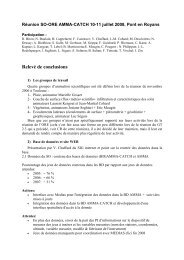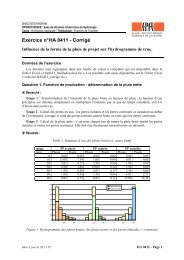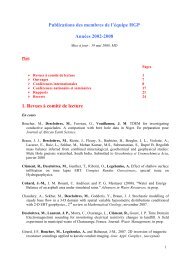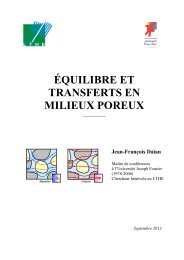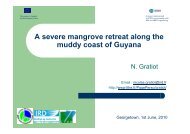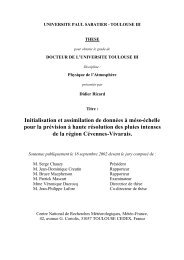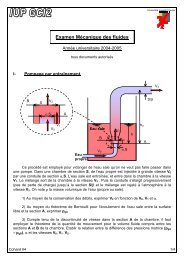Numerical simulation of sediment mixture deposition part 1 ... - LTHE
Numerical simulation of sediment mixture deposition part 1 ... - LTHE
Numerical simulation of sediment mixture deposition part 1 ... - LTHE
Create successful ePaper yourself
Turn your PDF publications into a flip-book with our unique Google optimized e-Paper software.
done through the presence <strong>of</strong> β j in equation (1) for transport<br />
capacity g v,j *. The bed material sorting equation is:<br />
with p the porosity <strong>of</strong> bed material; w act the width <strong>of</strong> the "active<br />
bed"; e m the mixing layer thickness; G j the total net volumetric<br />
<strong>sediment</strong> discharge <strong>of</strong> class j; Γ the alluvial bed area with<br />
respect to a reference plane; S j a source term (exchanges with<br />
suspended load, bank aggradation/degradation, lateral input).<br />
β j * is the volumetric fraction <strong>of</strong> <strong>sediment</strong> j in exchanges<br />
between surface and subsurface (see Figure 1). During <strong>sediment</strong><br />
<strong>deposition</strong>, and in the case <strong>of</strong> a constant mixing layer thickness,<br />
material issuing from the mixing layer is progressively buried<br />
in the underneath stratum β j * = β j . During erosion, and with this<br />
same condition <strong>of</strong> a constant thickness, the mixing layer is fed<br />
with material from the underneath stratum and β j * = volumetric<br />
fraction <strong>of</strong> <strong>sediment</strong> j in the first stratum under the mixing layer.<br />
Fig. 1.<br />
∂<br />
∂G<br />
---- [( 1–<br />
p)<br />
β<br />
∂t<br />
j w act e m ] + --------+ j<br />
∂x<br />
∂<br />
---- [( 1 – p)<br />
β *<br />
∂t<br />
j ( Γ – w act e m )] + S j = 0<br />
Rules for the storage <strong>of</strong> bed material during aggradation.<br />
(4)<br />
The appellation "mixing" layer is improper in the sense that it<br />
aims at representing different physical situations: (i) The <strong>deposition</strong><br />
layer, a sort <strong>of</strong> buffer zone for recording <strong>sediment</strong> quality.<br />
(ii) The mixed-layer, i.e. the bed zone which is stirred and<br />
whose <strong>sediment</strong> may be exposed to flow drag forces. A typical<br />
example is the dune whose material is alternatively exposed to<br />
erosion on the upstream face and further burden on the lee side.<br />
(iii) The surface layer during erosion, with the asymptotic situation<br />
<strong>of</strong> static armor. (iv) The transport layer, for example in the<br />
case <strong>of</strong> <strong>sediment</strong> transiting over a non-erodible bottom such as a<br />
rock outcrop or a concrete lining (Belleudy et al. 1990).<br />
One <strong>of</strong> the difficulties <strong>of</strong> SEDICOUP modeling is to maintain<br />
the continuity <strong>of</strong> these different meanings <strong>of</strong> the mixing layer<br />
among themselves especially while giving a numerical meaning<br />
and respecting constraints <strong>of</strong> its use as a "control volume". The<br />
mixing layer is the layer <strong>of</strong> bed material taken into account for<br />
<strong>sediment</strong> transport rate calculation and available for erosion.<br />
The mixing layer should not be too thin so that it remains the<br />
"same" during one time step <strong>of</strong> calculation; it should not be too<br />
large in order to reproduce effective changes <strong>of</strong> bed composition<br />
during the process under <strong>simulation</strong>. The thickness <strong>of</strong> the<br />
mixing layer may vary with its composition and with flow characteristics<br />
(reproducing for example the size <strong>of</strong> the dunes or the<br />
formation <strong>of</strong> the armor).<br />
In the present <strong>simulation</strong>, it fortunately takes its more simple<br />
meaning <strong>of</strong> a <strong>deposition</strong> layer. Its grain size distribution is<br />
directly linked to <strong>sediment</strong> transport rate (capacity), and is representative<br />
<strong>of</strong> <strong>sediment</strong> at the surface <strong>of</strong> the bed. Because there<br />
is no further mixing <strong>of</strong> deposited material, the depth <strong>of</strong> this <strong>deposition</strong><br />
layer is kept constant at the classical value <strong>of</strong> "the size <strong>of</strong><br />
the largest grain".<br />
Naturally the surface layer rises during <strong>deposition</strong>. Material<br />
which lays on the surface at time t will be buried a little time<br />
later and replaced by newly deposited material (the grain size<br />
distribution <strong>of</strong> which may be different). At the same time that a<br />
negative gradient <strong>of</strong> <strong>sediment</strong> transport feeds the surface layer<br />
from above, <strong>sediment</strong>s are exchanged between the surface layer<br />
(whose depth is given), and the subsurface.<br />
In SEDICOUP modeling, <strong>sediment</strong> joins the subsurface with<br />
the actual size distribution <strong>of</strong> the mixing layer. This <strong>sediment</strong> is<br />
recorded in the form <strong>of</strong> strata with a fixed thickness. These<br />
strata (and their <strong>sediment</strong> characteristics) remain available during<br />
the <strong>simulation</strong> in case further erosion takes place.<br />
In order to avoid possible numerical instabilities, the process for<br />
building successive strata is as illustrated in Figure 1. The modeler<br />
fixes the strata reference thickness e str before starting the<br />
<strong>simulation</strong>. When the thickness <strong>of</strong> the stratum which lies just<br />
below the mixing layer (and which receives its excess material)<br />
exceeds a* e str , this stratum is split into a stored stratum (whose<br />
thickness is e str ), and a new first substratum with initial thickness<br />
(1-a)* e str .<br />
For the <strong>simulation</strong>, the mixing layer thickness e m and the strata<br />
thickness e str are both equal to 0.05 m (nearly the largest grain<br />
size) and parameter a is set to 1.5.<br />
3 Description <strong>of</strong> <strong>simulation</strong> conditions<br />
Simulation conditions are defined in order to reproduce as<br />
closely as possible the conditions <strong>of</strong> run 3 which is described in<br />
Seal’s and Toro-Escobar’s papers.<br />
"Standard" numerical options for modeling are selected.<br />
Model<br />
The channel described by the model is 60 m long. Its typical<br />
cross-section is rectangular, 0.305 m wide. Cross-sections <strong>of</strong><br />
the computational grid are ∆x = 2.5 m a<strong>part</strong>. The channel floor<br />
is horizontal (elevation h = 0, no slope), and covered with<br />
gravel (d m = 42.3 mm).<br />
A Manning-Strickler relationship is used for regular head-loss<br />
calculation. Friction <strong>of</strong> channel walls is neglected.<br />
JOURNAL OF HYDRAULIC RESEARCH, VOL. 38, 2000, NO. 6 419


